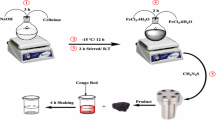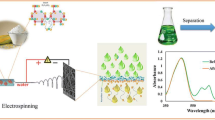Abstract
In this work, the usability of magnetic gelatin nanofiber (MGNF) for anionic dye removal was investigated in the aqueous solution. For this aim, the MGNF was prepared using the electrospinning technique with the addition of Fe3O4 nanopowders. After the characterization of MGNF with Fourier transform infrared spectroscopy, swelling test, scanning electron microscope, and energy-dispersive X-ray analysis, the adsorption performance of MGNF against the dye molecule, Orange G, was examined by changing the pH of the media, the dye concentration, and the ionic strength. The experimental results showed that the maximum adsorbed amount of Orange G was found as 15.6 mg/g at pH 3 value and the Orange G adsorption behavior was endothermic, physical, and suited to the Langmuir adsorption isotherm model. The adsorption kinetic of Orange G was evaluated with the pseudo-first-order, the pseudo-second-order, and the Elovich kinetic models and the pseudo-second-order model results fitted the experimental findings as compared to the other models. The affordable magnetic adsorbent was capable of maintaining its stability after five consecutive adsorption, desorption, and regeneration cycles without significant loss of adsorption capacity.





Similar content being viewed by others

References
Osagie C, Othmani A, Ghosh S, Malloum A, Esfahani KZ, Ahmadi S (2021) Dyes adsorption from aqueous media through the nanotechnology: A review. J Mater Res Technol 14:2195–2218
Gusain D, Dubey S, Upadhyay SN, Weng CH, Sharma YC (2016) Studies on optimization of removal of orange G from aqueous solutions by a novel nano adsorbent, nano zirconia. Ind Eng Chem Res 33:42–50
Dev VV, Wilson B, Nair KK, Antony S, Krishnan KA (2021) Response surface modeling of Orange-G adsorption onto surface tuned ragi husk. Colloids Interface Sci Commun 41:100363
Mondal MK, Singh S, Umareddy M, Dasgupta B (2010) Removal of Orange G from aqueous solution by hematite: isotherm and mass transfer studies. Korean J Chem Eng 27(6):1811–1815
Chung KT (2016) Azo dyes and human health: a review. J Environ Sci Health C Toxicol Carcinog 34(4):233–261
Yang W, Deng Z, Wang Y, Ma L, Zhou K, Liu L, Wei Q (2022) Porous boron-doped diamond for efficient electrocatalytic elimination of azo dye Orange G. Sep Purif Technol 293:121100
Katheresan V, Kansedo J, Lau SY (2018) Efficiency of various recent wastewater dye removal methods: a review. J Environ Chem Eng 6(4):4776–4697
Tang L, Yu J, Pang Y et al (2018) Sustainable efficient adsorbent: Alkali-acid modified magnetic biochar derived from sewage sludge for aqueous organic contaminant removal. Chem Eng J 336:160–169
Pandian CJ, Palanivel R, Dhananasekaran S (2015) Green synthesis of nickel nanoparticles using Ocimum sanctum and their application in dye and pollutant adsorption. Chin J Chem Eng 23(8):1307–1315
Ramesh AV, Devi DR, Botsa SM, Basavaiah K (2018) Facile green synthesis of Fe3O4 nanoparticles using aqueous leaf extract of Zanthoxylum armatum DC for efficient adsorption of methylene blue. J Asian Ceram Soc 6(2):145–155
Salam MA, Kosa SA, Beladi A (2017) Application of nanoclay for the adsorptive removal of Orange G dye from aqueous solution. J Mol Liq 241:469–477
Kumar S, Bhanjana G, Jangra K, Dilbaghi N, Umar A (2014) Utilization of carbon nanotubes for the removal of rhodamine B dye from aqueous solutions. J Nanosci Nanotechnol 14(6):4331–4336
Jawad AH, Abdulhameed AS et al (2022) Cross-linked chitosan-glyoxal/kaolin clay composite: parametric optimization for color removal and cod reduction of remazol brilliant blue r dye. J Polym Environ 30:164–178
Cheng J, Zhan C, Wu J et al (2020) Highly efficient removal of methylene blue dye from an aqueous solution using cellulose acetate nanofibrous membranes modified by polydopamine. ACS Omega 5(10):5489–5400
Thamer BM, El-Hamshay H, Al-Deyab SS, El-Newehy MH (2019) Functionalized electrospun carbon nanofibers for removal of cationic dye. Arab J Chem 12:747–759
Jawad AH, Selvasembian R, Abdulhameed AS, Hassan SSA, Alothman ZA, Wilson LD (2022) Process optimization and adsorptive mechanism for reactive blue 19 dye by magnetic crosslinked chitosan/MgO/Fe3O4 biocomposite. J Polym Environ 30:2759–2773
Jawad AH, Hameed BH, Abulhameed AS (2022) Synthesis of biohybrid magnetic chitosan-polyvinyl alcohol/MgO nanocomposite blend for remazol brilliant blue R dye adsorption: solo and collective parametric optimization. Polym Bull. https://doi.org/10.1007/s00289-022-04294-z
Reddy DHK, Lee SM (2013) Application of magnetic chitosan composites for the removal of toxic metal and dyes from aqueous solutions. Adv Colloid Interface Sci 201:68–93
Makarchuk OV, Dotsova TA, Astrelin IM (2016) Magnetic nanocomposites as efficient sorption materials for removing dyes from aqueous solution. Nanoscale Res Lett 11(161):1–7
Jawad AH, Abulhammed AS, Selvasembian R, Alothman ZA, Wilson LD (2022) Magnetic biohybrid chitosan-ethylene glycol diglycidyl ether/ magnesium oxide/Fe3O4 nanocomposite for textile dye removal: Box-Behnken design optimization and mechanism study. J Polym Res 29(207):1–15
Samandari SS, Samandar SS, Yekta HJ, Mohseni M (2017) Adsorption of anionic and cationic dyes from aqueous solution using gelatin-based magnetic nanocomposite beads comprising carboxylic acid functionalized carbon nanotube. Chem Eng J 308:1133–1144
Rigueto CVT, Nazari MT, Massuda LÂ, Ostwald BEP, Piccin JS, Dettmer A (2021) Production and environmental applications of gelatin-based composite adsorbents for contaminants removal: a review. Environ Chem Lett 19:2465–2486
Mir AA, Amooey AA, Ghasem S (2018) Adsorption of direct yellow 12 from aqueous solutions by an iron oxide-gelatin nanoadsorbent; kinetic, isotherm and mechanism analysis. J Clean Prod 170:570–580
Li W, Ma Q, Bai Y, Xu D, Wu M, Ma H (2018) Facile fabrication of gelatin/bentonite composite beads for tunable removal of anionic and cationic dyes. Chem Eng Res Des 134:336–346
Ma Y, Qi P, Ju J et al (2019) Gelatin/alginate composite nanofiber membranes for effective and even adsorption of cationic dyes. Compos B Eng 162:671–677
Chen Y, Ma Y, Lu W, Guo Y, Zhu Y, Lu J, Sonh Y (2018) Environmentally friendly gelatin/β-cyclodextrin composite fiber adsorbents for the efficient removal of dyes from wastewater. Macromolecules 23(2473):1–17
Luo M, Huang C, Chen F, Chen C, Li H (2021) Removal of aqueous cr(VI) using magnetic-gelatin supported on Brassica-straw biochar. J Dispers Sci Technol 42(11):1710–1722
Dolgormaa A, Lv CJ, Li Y, Yang J, Yang JX, Chen P, Wang HP, Huang J (2018) Adsorption of cu(II) and zn(II) ions from aqueous solution by gel/pva-modified super-paramagnetic iron oxide nanoparticles. Molecules 23(2982):1–15
Gulsun T, Inal M, Akdag Y, Izat N, Oner L, Sahin S (2022) The development and characterization of electrospun gelatin nanofibers containing indomethacin and curcumin for accelerated wound healing. J Drug Deliv Sci Technol 67:103000
Ko JH, Yin HY, An J et al (2010) Characterization cross-linked gelatin nanofibers through electrospinning. Macromol Res 16(2):137–143
Cebi N, Durak MZ, Toker OS, Sagdıc O, Arici M (2016) An evaluation of Fourier transforms infrared spectroscopy method for the classification and discrimination of bovine, porcine and fish gelatins. Food Chem 190:1109–1115
Samal KS, Goranov V, Dask M et al (2015) Multilayered magnetic gelatin membrane scaffolds. ACS Appl Mater Interfaces 7:23098–23109
Wang T, Zhao P, Lu N, Chen H, Zhang C, Hou X (2016) Facile fabrication of Fe3O4/MIL-101(Cr) for effective removal of acid red 1 and Orange G from aqueous solution. Chem Eng J 295:403–413
Cai Mi SuJ, Zhu Y et al (2016) Decolorization of azo dyes Orange G using hydrodynamic cavitation coupled with heterogeneous Fenton process. Ultrason Sonochem 128:302–310
Foo KY, Hameed BH (2010) Insights into the modeling of adsorption isotherm systems. Chem Eng J 156(1):2–10
Gündüz F, Bayrak B (2017) Biosorption of malachite green from an aqueous solution using pomegranate peel: equilibrium modeling, kinetic and thermodynamic studies. J Mol Liq 243:790–798
Dada AO, Olakan AP, Olatunya AM, Dada O (2012) Langmuir, freundlich, temkin and dubinin-radushkevich isotherms studies of equilibrium sorption of zn2+ unto phosphoric acid modified rice husk. J Appl Chem 3:38–45
Yılmaz E, Özgür E, Bereli N, Türkmen D, Denizli A (2017) Plastic antibody based surface plasmon resonance nanosensors for selective atrazine detection. Mater Sci Eng C 73:603–610
Ahmad MA, Ahmad N, Bello OS (2015) Modified durian seed as adsorbent for the removal of methyl red dye from aqueous solutions. Appl Water Sci 5:407–423
Cui L, Xiong Z, Guo Y, Liu Y, Zhao J, Zhang C, Zhu P (2015) Fabrication of interpenetrating polymer network chitosan/gelatin porous materials and study on dye adsorption properties. Carbohydr Polym 132:330–337
Hsini A, Esseleri A, Aarab N et al (2020) Elaboration of novel polyaniline@Almond shell biocomposite for effective removal of hexavalent chromium ions and Orange G dye from aqueous solutions. Environ Sci Pollut Res 27:15245–15258
Arulkumar M, Sathishkumar P, Palvannan T (2011) Optimization of Orange G dye adsorption by activated carbon of Thespesia populnea pods using response surface methodology. J Hazard Mater 186:827–834
Banerjee S, Dubey S, Gautam RK, Chattopadhyaya MC, Sharma Y (2019) Adsorption characteristics of alumina nanoparticles for the removal of hazardous dye, Orange G from aqueous solutions. Arab J Chem 12:5339–5354
Sutirman ZA, Sanagi MM, Karim KJA, Naim AA, Ibrahim WAW (2019) Enhanced removal of Orange G from aqueous solutions by modified chitosan beads: performance and mechanism. Int J Biol Macromol 133:1260–1267
Singh J, UMA, Banerjee S, Gusain D, Sharma YC (2011) Equilibrium modelling and thermodynamics of removal of orange g from its aqueous solutions. J Appl Phytotechnol Environ Sanit 6(3):317–326
Acknowledgements
I would like to thank Prof. Dr. Adil Denizli for his kind help and support.
Author information
Authors and Affiliations
Corresponding author
Additional information
Publisher's Note
Springer Nature remains neutral with regard to jurisdictional claims in published maps and institutional affiliations.
Supplementary Information
Below is the link to the electronic supplementary material.
Rights and permissions
Springer Nature or its licensor holds exclusive rights to this article under a publishing agreement with the author(s) or other rightsholder(s); author self-archiving of the accepted manuscript version of this article is solely governed by the terms of such publishing agreement and applicable law.
About this article
Cite this article
Topçu, A.A. The adsorption performance of magnetic gelatin nanofiber for Orange G removal. Polym. Bull. 80, 1017–1029 (2023). https://doi.org/10.1007/s00289-022-04464-z
Received:
Revised:
Accepted:
Published:
Issue Date:
DOI: https://doi.org/10.1007/s00289-022-04464-z



